
Mendive. Journal on Education, 21(2), e3109 
Translated from the original in Spanish
Original article
Active Learning in Higher Education. Strategy in virtuality
Aprendizaje Activo en Educación Superior. Estrategia en la virtualidad
Aprendizagem Ativa no Ensino Superior. Estratégia na virtualidade
Pedro Luis Alfonso1![]() http://orcid.org/0000-0001-5447-8518
http://orcid.org/0000-0001-5447-8518
1 National University of the Northeast. Faculty of Exact and Natural Sciences and
Surveying. Argentina ![]() plalfonzo@hotmail.com
plalfonzo@hotmail.com
| Alfonzo, P. (2023). Active Learning in higher education. Strategy in virtuality. Mendive. Revista de Educación, 21(2), e3109. https://mendive.upr.edu.cu/index.php/MendiveUPR/article/view/3109 |
Received: June 6, 2022
Accepted: July 10, 2022
ABSTRACT
The global pandemic and the isolation, social, preventive and mandatory arranged by different government and university estates, which led educational institutions to adapt the curricular activities that were developed in person to the virtual modality using new didactic strategies that required the use of technologies. In this sense, in learning with the virtual modality, the autonomy of the student in learning is important to strengthen their cognitive maturity, in addition to active learning that allows them to form critical thinking, among others. Active Learning is considered as a didactic strategy where the active participation of the student with their learning process is promoted. Therefore, this work presents an innovative strategy of the application of Active Learning as a learning strategy in a higher education context, with a view to contributing to the professional training of students who are studying a degree course in a virtual / remote, way through the application of new didactic strategies in the face of the impossibility of implementing face-to-face activities. The results show that the didactic strategy applied was highly positive.
Keywords: Active Learning; Higher Education; virtual teaching; didactic strategy.
RESUMEN
La pandemia a nivel mundial y el aislamiento social, preventivo y obligatorio, dispuesto por diferentes estamentos gubernamentales y universitarios, llevó a las instituciones educativas a adaptar las actividades curriculares que se desarrollaban de manera presencial a la modalidad virtual, utilizando nuevas estrategias didácticas que requirieron del uso de tecnologías. En este sentido, en un aprendizaje con la modalidad virtual, es importante la autonomía del estudiante para fortalecer su madurez cognitiva, además de un aprendizaje activo que le permita formar un pensamiento crítico. Se considera el Aprendizaje Activo como una estrategia didáctica donde se promueve la participación activa del estudiante con su proceso de aprendizaje. Por lo expuesto, en este trabajo se presenta una estrategia innovadora en la aplicación del Aprendizaje Activo en un contexto de Educación Superior, con miras a aportar a la formación profesional de los estudiantes que cursan una asignatura de grado de manera virtual/remota, a través de la aplicación de nuevas estrategias didácticas, ante la imposibilidad de implementar actividades presenciales. Los resultados muestran que la estrategia didáctica aplicada resultó altamente positiva.
Palabras clave: Aprendizaje Activo; Educación Superior; enseñanza virtual; estrategia didáctica.
RESUMO
A pandemia mundial e o isolamento social, preventivo e obrigatório, ordenado por diferentes níveis governamentais e universitários, levaram as instituições de ensino a adequar as atividades curriculares que eram realizadas presencialmente para a modalidade virtual, utilizando novas estratégias didáticas que exigiam o uso de tecnologias. Nesse sentido, na aprendizagem com a modalidade virtual, a autonomia do aluno é importante para fortalecer sua maturidade cognitiva, além de uma aprendizagem ativa que lhe permite formar um pensamento crítico. A Aprendizagem Ativa é considerada uma estratégia didática onde se promove a participação ativa do aluno em seu processo de aprendizagem. Por estas razões, este artigo apresenta uma estratégia inovadora na aplicação da Aprendizagem Ativa em contexto de Ensino Superior, com vista a contribuir para a formação profissional dos alunos que frequentam uma disciplina de licenciatura virtual/à distância, através da aplicação de novas ferramentas didáticas estratégias, dada a impossibilidade de implementação de atividades presenciais. Os resultados mostram que a estratégia didática aplicada foi altamente positiva.
Palavras-chave: Aprendizagem Ativa; Educação superior; ensino virtual; estratégia didática.
INTRODUCTION
Higher Education spaces face the challenge of contributing to the growth of the Software industry and participating in the training of updated professionals, according to the demands of the labor market. In this sense, universities as creators of knowledge contribute to the generation of technology through the explicit transfer that they carry out or through the intellectual capital that emerges from them (Mariño and Alfonzo, 2017).
Learning is enhanced when students actively participate, with the development of new content, through group discussions and problem solving (Gunn & Raven, 2017).
Student-centered learning theories have promoted the use of active methodologies, which place the student at the center of the process and teaching does not depend on the teacher and the content, but on the student and the activities that he or she carries out to achieve learning (Silva Quiróz and Maturana Castillo, 2017).
In this sense, Prieto Navarro (2006) expresses that Active Learning (AA) is included in these teaching methodologies and maintains that conventional university teaching has provided few opportunities for active learning in the classroom, despite the evidence evidence that indicates the advantages of including opportunities for active learning in the classroom. It also stresses that AA is essential to contribute to quality learning; helps students become better professionals and become more actively engaged in their learning.
García Hidalgo and Diez Rodríguez (2018) define AA as a pedagogical strategy, which encourages the participation and cognitive growth of students and a better predisposition of teachers towards the transmission of knowledge, through training inspired by experiences.
On the other hand, the pandemic had a high impact on people's health worldwide, which motivated governments to take measures to combat it and protect the health of their citizens (García Peñalvo, García Holgado, Vázquez Ingelmo and Sánchez Prieto, 2021; Llorens Largo, Villagrá Arnedo, Gallego Durán and Molina Carmona, 2021). This led educational institutions to adapt the curricular activities that were carried out in person to the virtual modality, using new didactic strategies with the requirement of the use of technologies.
Sánchez Rosal (2021) argues that, for optimal development in learning with the virtual modality, it is important to establish the student's freedom in content management, autonomy in learning to strengthen their cognitive maturity, active learning that allows form critical thinking and greater interaction with their peers, among others; which allows deducing that active methodologies are feasible to implement in the teaching-learning process through the virtual modality.
It coincides with Mariño, Alfonzo and Gómez Codutti (2017), who affirm that innovation is an element of the knowledge society. For these reasons, this paper presents an innovative strategy for the application of AA as a didactic strategy in a context of Higher Education, with a view to contributing to the professional training of students who are studying a degree course that is developed through a methodology face-to-face teaching, actively involving them in this process and thus fostering creativity during their learning process.
As innovation, it refers to the implementation of OA in the development of software products in a virtual/remote way, through the application of new didactic strategies given the impossibility of implementing face-to-face activities, taking into account the pandemic and Preventive Social Isolation and Mandatory (ASPO), arranged by different government and university bodies.
The initiative of the application of OA in Higher Education is dealt with in university environments, as mentioned in Armellini, Teixeira Antunes and Howe (2021); García Hidalgo and Diez Rodríguez (2018); Garza Garza, Rivera and Cubero (2018); Garcia Penalvo et al. (2021); Gunn and Raven (2017); Llorens Largo et al. (2021); Silva Quiróz and Maturana Castillo (2017); Venton and Pompano (2021).
Academic context
Programming Workshop II is an integrating subject of the Bachelor's degree in Information Systems, which is taught at the Faculty of Exact and Natural Sciences and Surveying of the National University of the Northeast (UNNE).
Its objectives are: to integrate the concepts acquired in previous subjects of the study plan, oriented towards the development of computer applications and adopting the systematic approach and "good practices" promoted by Software Engineering; consolidate the concepts with an intense development task (individual or in teams), following all the conceptual stages of a software development project, from its specification to its verification and validation.
The aforementioned subject is fundamental in professional training as graduates of an intermediate undergraduate degree. In this sense, this subject is strongly committed, contributing to train professionals with the necessary theoretical and practical knowledge to carry out the integral development of a computer application that integrates methodologies and techniques of the different programming paradigms, from its initial stage to its completion. the completion thereof; in addition to promoting research as a training process, self-learning based on research, teamwork, among others.
MATERIALS AND METHODS
In order to elaborate the exposed didactic strategy, a methodology composed of the following stages was followed:
The data collection method is quantitative and a "self-administered" questionnaire was used as the collection instrument; that is, the questionnaire was provided directly to the participants to answer. For its preparation, a Google Form was used and the link was shared via email to the students. The Likert scale was used to quantify the items that constitute the elaborated questionnaire (Hernández Sampieri, Fernández Collado and Baptista Lucio, 2014). The questionnaire included four affirmative questions and a five-point Likert-type scale (Hernández Sampieri et al., 2014) was used to record the responses (5-Strongly agree; 4-Agree; 3-No opinion; 2-In disagree and 1-Strongly disagree). In addition, a question was included with the purpose of knowing the student's satisfaction regarding the general training received, where (5) indicates Very satisfied, (4) Quite satisfied, (3) Neither satisfied nor dissatisfied, (2) Not very satisfied and (1) Not satisfied.
Reliability is defined as the degree to which an instrument produces consistent and coherent results, and the reliability of a measurement instrument refers to the degree to which its application, repeated to the same individual or object, produces the same results (Hernández Sampieri et al., 2014).
The reliability of the measurement instrument used to collect information regarding the experience of applying the AA was validated, through the internal consistency coefficient Cronbach's Alpha (Cronbach and Shavelson, 2004), with a five-point Likert scale, using the form Microsoft Excel calculation tool to perform reliability analysis and data analysis. Cronbach's alpha value ranges from 0 to 1. The closer the alpha value is to 1, the greater the internal consistency of the items analyzed. Gliem and Gliem (2003) suggest the following scores to assess Cronbach's alpha: alpha >0.9 is excellent; alpha coefficient >0.8 is good; alpha coefficient >0.7 is acceptable; alpha coefficient >0.6 is questionable; alpha coefficient >0.5 is poor.
From the collected data, a value of 0.83 was obtained corresponding to the internal consistency coefficient Cronbach's Alpha, which indicates a good internal consistency between the items that make up the measurement instrument; therefore, the questionnaire is considered reliable.
RESULTS
Development of the didactic strategy
As previously mentioned, the subject where the didactic strategy is implemented contributes to train professionals with the necessary knowledge to carry out the integral development of a computer application, following the practices proposed from Software Engineering (IS).
Due to the above, and given the impossibility of implementing face-to-face activities, taking into account the Preventive and Mandatory Social Isolation (ASPO) established by different government and university bodies, the didactic activities that were traditionally carried out in a virtual/remote modality were adapted to in person in the computer lab. In this sense, new strategies to be addressed were implemented, according to content planning, evaluations and tutorials (see table 1).
Table 1- Strategies addressed by type of activity
Activity type |
Instruments |
Technologies to use |
Development of practical or theoretical-practical activities |
Practical work guide |
Videoconference |
tutoring instances _ |
Query forum (asynchronous) |
Moodle platform |
ASSESSMENT |
||
Assessment formative ( process ) |
Project progress monitoring |
Moodle Platform (Task Resource) |
Evaluative instances to prove knowledge |
Delivery of projects |
Moodle Platform (Task Resource) |
BIBLIOGRAPHY |
||
Bibliography available for students |
Digitized bibliography |
moodle platform |
COMMUNICATION |
||
Communication |
Unscheduled interaction |
Moodle platform (Consultation forums) |
Next, the inclusion and application of ML in a software process model as an ML strategy is described, with the subject Programming Workshop II as the validation context. The strategy was applied to the "software development" stage, in order to start using this methodology more systematically, taking into account that one of the objectives of the subject is to integrate the concepts acquired in previous subjects of the curriculum. study, oriented towards the development of computer applications.
They agree with Silva Quiróz and Maturana Castillo (2017, p. 119) that in "a student-centered learning process, this is a main actor and must be willing to work as a team, demonstrate flexibility, proactivity and autonomy, together with a permanent disposition towards reflection".
This proposal is based on the organization of the AA proposed by McAlpine (2004), cited in Prieto Navarro (2006), which incorporates the activity of the students as the key stage to enhance the quality of their learning. The following phases that structure the global teaching-learning process were carried out:
In addition, the objectives to be achieved through the realization of activities based on the intensive experimental practice to be carried out during the course and how this is related to their professional training were exposed. It was explained what the software product to be developed consists of, the possible technological tools to be used, the software verification and validation techniques as part of the software quality assurance process. On the other hand, the importance of prior knowledge, teamwork and research as a training and self-learning process was mentioned, based on research, taking into account the rapid advance of technological products related to the production of software and labor market requirements.
It was explained that, from the ASPO, the didactic activities of the subject had to be adapted to the virtual/remote modality and what are the strategies to be addressed according to the type of activity shown in Table 1.
In the Virtual Classroom of the subject, through the Moodle platform, the study material was made available to the student, as well as bibliography and sites of interest related to programming languages, software development methodologies and websites. consultation on the topics covered.
Figure 1 graphically displays a process model, where ML is included as a didactic strategy in the generation of software products, specifically in the stages: FrameWorks research; software design and development based on prioritized requirements; evaluation and performance tests. Two activities were defined, from which the software product is generated. In the first, research is carried out on how to develop user interfaces, their coding in the selected programming language and their subsequent evaluation, which allow verifying the software that is developed according to the requested requirements (edges with green dotted lines). The second consists of evaluating whether the developed functional modules behave correctly (borders with red dotted lines). It should be noted that the proposed active process model is independent of the software development process to be used. Table 2 describes the activities to be carried out in each of the mentioned stages.

Fig. 1- Process model including AA
Table 2- Stages and activities in the proposed process model
Stages |
Activities |
Investigation initial |
|
Requirements specification |
|
Design and development |
|
Evaluation / verification |
|
Evidence |
|
Regarding the summative evaluation, the student had to accredit the ability to handle theoretical and practical concepts, according to the topic to be investigated in the previous phase; Checking, in this way, if they have managed to learn the skills required to pass the course, both in knowledge and skills in the application of the techniques and tools used in software development. For both instances, the technologies shown in Table 1 were used.
Data analysis
After completing the subject, a survey was carried out in order to find out the opinion of the students regarding the strategy developed and generated virtually/remotely in areas of Higher Education.
Regarding the first affirmative question: "Research as a training process contributed to my future as a professional" and the second: "The teaching methodology contributed to self-learning", he analyzes, taking into account some of the objectives of the subject, where encourages research and promotes self-learning. The data obtained are displayed in Figure 2 and Figure 3, respectively.
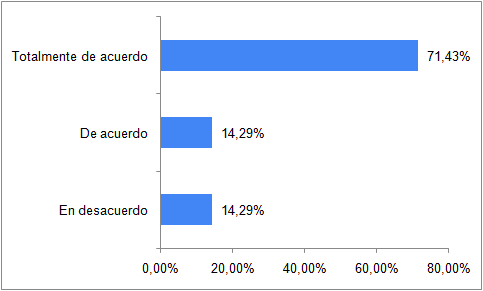
Fig. 2- Percentage of Agree regarding research as a training process

Fig. 3- Percentage of Agree regarding self-learning
In relation to the third affirmative question: "The teaching methodology used improved my ability to work in a team", it consisted of inquiring about the teaching methodology implemented in the course; From this, it is expected to acquire skills in the development of a software product through an intense team development task. Of the total number of respondents, it was observed (figure 4) that 36% (five students) answered that they totally agreed, 36% (five students) agreed and 7% (one student) disagreed. Based on the data obtained, it can be seen that, for the most part, the students answered that they agreed with the methodology used.
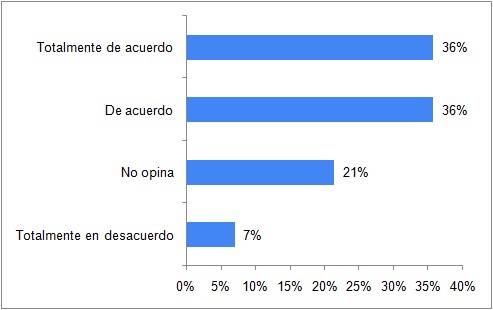
Fig. 4- Percentage of Agree on teamwork
The fourth affirmative question: "The previous knowledge helped in the development of the works in a satisfactory way", consisted of analyzing the previous knowledge; that is to say, it investigates the concepts acquired in previous subjects of the study plan, oriented towards the development of computer applications and if these were sufficient and contributed affirmatively to the development of the works proposed from the subject. The importance of previous knowledge is highlighted, taking into account that the subject is inclusive of the same and allowing, in this way, the acquisition of new knowledge. The analysis of the results can be seen in figure 5, where 50% (seven students) responded that they totally agree and 43% (six students) agreed.

Fig. 5- Percentage of Agree, regarding previous knowledge
In order to find out the student's satisfaction in relation to the general training received during the course, they were asked to assign an assessment to the following question: "express your degree of general satisfaction with the training received". Figure 6 shows that 57% (eight students) were very satisfied and 29% (four students) quite satisfied. Based on the data obtained, a high level of satisfaction with the general training received is observed.
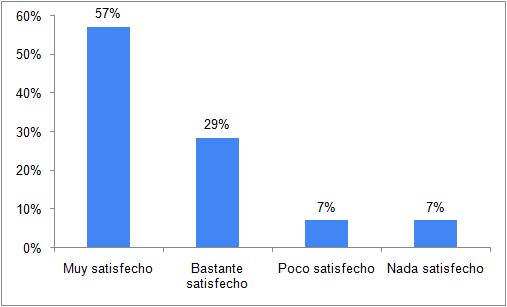
Fig. 6- Percentage of general satisfaction regarding the training received
Measurement of student attitude
To measure the Student Attitude (SA) regarding the statements of each question, the following formula is used, where a score is considered high or low depending on the number of items or statements obtained (Hernández Sampieri et al., 2014).
![]()
Where:
i: are the items or questions
Pi : are the scores obtained in each item or question
n: are the number of items or questions
Next, the scale to measure EA is presented, considering the questionnaire implemented and described in this work, which had four affirmative questions with a five-point Likert-type scale, where (5) indicates "Totally agree" and (1) indicates "Strongly disagree"; therefore, there is a maximum score of 20 points (5+5+5+5) and a minimum score of 4 points (1+1+1+1); In this sense, for each survey participant there is the following EA assessment scale (Hernández Sampieri et al., 2014):
Figure 7 shows the EA of the students when applying the formula and the scale, according to the score obtained and, in Figure 8, it can be seen that, for the most part (86%), the EA of the students was very favorable and 7% favorable and unfavorable, respectively. This would allow us to affirm, in a general way, that the didactic strategy applied was positive, as well as research as a training process, self-learning based on research, teamwork and the contribution of prior knowledge.
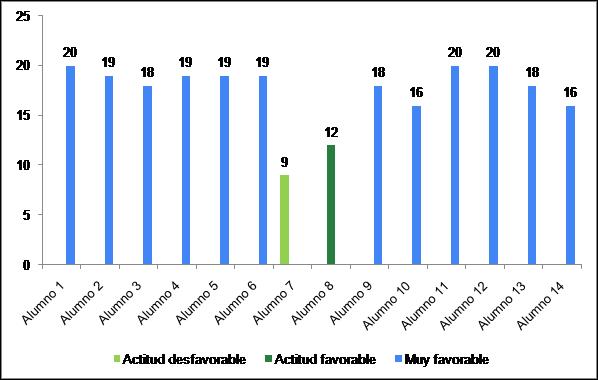
Fig. 7- Attitude of the Students regarding the experience
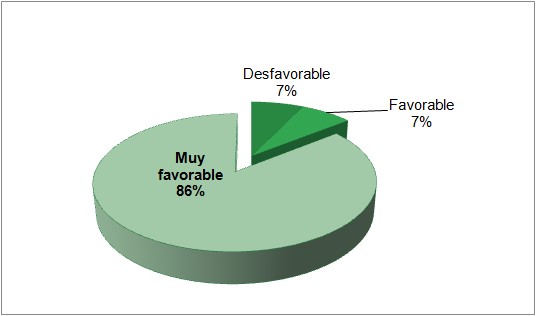
Fig. 8- Percentage regarding the Attitude of the Students (AE)
DISCUSSION
A didactic strategy was presented in the application of Active Learning in a virtual/remote way in a university context, with the aim of contributing to the professional training of students. In this sense, the implementation of the AA and the integration with the proposed didactic strategy allowed completing the following competencies in the students: ability to solve problems, critical thinking, decision making, understanding the importance of teamwork, developing research skills, develop self-learning and collaborative learning capacities.
Based on the results obtained, it was possible to show that the strategies addressed according to the type of activity were satisfactory, since the students were actively involved through the AA in the processes of acquisition and construction of knowledge. Based on the foregoing, it can be globally inferred that the didactic strategy applied was highly positive, serving this experience as feedback for its application in subsequent school years.
REFERENCES
Armellini, A., Teixeira Antunes, V. y Howe, R. (2021). Student Perspectives on Learning Experiences in a Higher Education Active Blended Learning Context. TechTrends, 65. 433-443. https://doi.org/10.1007/s11528-021-00593-w
Cronbach, L. y Shavelson, R. (2004). My current thoughts on coefficient alpha and successor procedures. Educational and psychological measurement, 64(3), 391-418.
Garza Garza, J., Rivera, M. H. y Cubero, A. (2018). Efectividad de secuencias didácticas y técnicas de aprendizaje activo en cursos de electrónica digital. Revista electrónica anfei digital, 4(8). 1-9.
García Hidalgo, Y. y Diez Rodríguez, H. (2018). Aprendizaje activo en los estudiantes de ingeniería industrial. Universidad politécnica de la región ribereña. Revista digital de Medio Ambiente "Ojeando la agenda", (51). 24-33.
García Peñalvo, F., García Holgado, A., Vázquez Ingelmo, A. y Sánchez Prieto, J. C. (2021). Planning, communication and active methodologies: Online assessment of the software engineering subject during the COVID-19 crisis. RIED. Revista Iberoamericana de Educación a Distancia, 24(2). 41-66. https://doi.org/10.5944/ried.24.2.27689
Gliem, J. y Gliem, R. (2003). Calculating, interpreting, and reporting Cronbach's alpha reliability coefficient for Likert-type scales. Midwest Research to Practice Conference in Adult, Continuing and Community Education. Columbus.
Gunn, C. y Raven, J. (2017). Smart education: Introducing active learning engineering classrooms in the Middle East. Fourth HCT Information Technology Trends (ITT), 1-4. https://doi.org/10.1109/CTIT.2017.8259556
Llorens Largo, F., Villagrá Arnedo, C., Gallego Durán, F. y Molina-Carmona, R. (2021). CoVId-proof: cómo el aprendizaje basado en proyectos ha soportado el confinamiento. Campus Virtuales, 10(1), 73-88.
Mariño, S. I. y Alfonzo, P. L. (2017). Evidencia de disciplina Informática en producciones finales de carrera del año 2015. Congreso Internacional de Ciencias de la Computación y Sistemas de Información (CICCSI). Mendoza, Argentina.
Mariño, S. I., Alfonzo, P. L. y Gómez Codutti, A. (2017). El Aprendizaje Basado en Problemas. Una experiencia en la asignatura Modelos y Simulación, período 2015-2016. Premisa, 19(75), 44-55.
Prieto Navarro, L. (2006). Aprendizaje activo en el aula universitaria: el caso del aprendizaje basado en problemas. Miscelánea Comillas. Revista de Ciencias Humanas y Sociales, 64(124). 173-196.
Hernández Sampieri, R., Fernández Collado, C. y Baptista Lucio, M. (2014). Metodología de la investigación. Quinta edición. McGRAW-HILL.
Sánchez Rosal, A. (2021). Aprendiendo desde la virtualidad. Competencias en contextos educativos virtuales. Educ@ción en Contexto, 7(13), 9-32.
Silva Quiróz, J. y Maturana Castillo, D. (2017). Una propuesta de modelo para introducir metodologías activas. Innovación Educativa, 17(73). 117-132.
Venton, J. y Pompano, R. (2021). Strategies for enhancing remote student engagement through active learning. Anal Bioanal Chem, 413, 1507-1512. https://doi.org/10.1007/s00216-021-03159-0
Conflict of interests:
The author declares that he has no conflicts of interest.
Contribution of the authors:
The author participated in the design and writing of the work and analysis of the documents.
![]()
This work is licensed under a Creative Commons Attribution- NonCommercial 4.0
International License